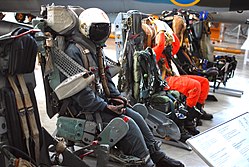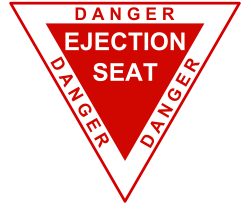Ejection seat
In aircraft, an ejection seat or ejector seat is a system designed to rescue the pilot or other crew of an aircraft (usually military) in an emergency.[1] In most designs, the seat is propelled out of the aircraft by a small explosion or rocket motor, carrying the pilot with it. The concept of an ejectable escape crew capsule has also been tried. Once clear of the aircraft, the ejection seat deploys a parachute. Ejection seats are common on certain types of military aircraft, and can save people's lives.
Ejection Seat Media
Martin-Baker WY6AM ejection seat.
United States Air Force F-15 Eagle ejection seat test using a crash test dummy.
Seat on display at RAF Museum Cosford
An Aviation Structural Mechanic works on an ejection seat removed from the cockpit of an EA-6B Prowler aboard USS John C. Stennis.
Lt. (j.g.) William Belden ejects from an A-4E Skyhawk as it rolls into the carrier's catwalk after a brake failure on the deck of the USS Shangri-La on 2 July 1970. The pilot was recovered by helicopter.
Capt. Christopher Stricklin ejects from his F-16 aircraft with an ACES II ejection seat on 14 September 2003 at Mountain Home AFB, Idaho. Stricklin was not injured.
The ACES II Ejection seat commonly used on United States Air Force jets
References
- ↑ A Dictionary of Aviation, David W. Wragg. ISBN 9780850451634, 1st Edition Published by Osprey, 1973 / Published by Frederick Fell, Inc., NY, 1974 (1st American Edition.), Page 117.









